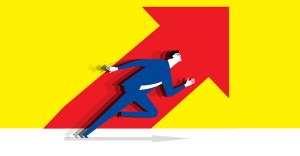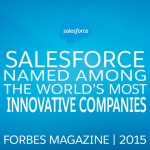
This article by John Rampton is part of our Blogtober event, which features blog posts written by industry influencers in support of Breast Cancer Awareness Month.
Highly successful entrepreneurs often go to the beat of their own drum. They have to. Statistics show the vast majority of new businesses fail, which means entrepreneurs must do things differently than other business people. And to the entrepreneur, these habits seem perfectly normal.
Personally, I’ve started, bought, grown, and sold several companies, and have been named as one of the most influential online marketers in the world. Someone recently told me that my habits are different from others. I prefer “unique” over different. When I reflected on this, it became clear that my habits are similar to those of many other highly successful entrepreneurs. Perhaps these habits will help you as well.
1. Get a lot of work done between 5am – 7am.
General Electric’s CEO, Jeff Immelt, gets up at 5:30am. Ursula Burns, Chairwoman and CEO of Xerox, wakes up at 5:15am. In fact, a number of top-level executives and entrepreneurs wake up before dawn.
While others are sleeping, I find this is the best time to get most of my thinking time in. During “normal” business hours, there are multiple disruptions that do not provide the right environment for thinking about ideas, problems, and opportunities. However, in the early morning hours, even the crickets are in bed so it gives me a great chance to only focus on my thoughts. There is no email or phone calls. It’s just my brain and I. Many other successful entrepreneurs have done the same by choosing these quiet, dark hours to do some of their best work. This also frees up time during the day to only focus on those immediate needs and daily tasks rather than becoming frustrated by trying to do both.
2. Use the Tony Hsieh of Zappos method for answering emails in one fell swoop.
Hsieh created the Yesterbox system of email management, and has noted that he likes to organize his emails into various categories and create a separate inbox just for those emails that require his attention but that are not pressing. Just about every entrepreneur has his or her own method for dealing with an overwhelming inbox. I have found that it helps me to save all those emails that just take seconds to answer for the end of the workday rather than using that time during the day when I have other projects, decisions, and people who require my immediate attention. This process has been proven to be a time “maximize” in terms of getting things done.

3. Conduct meetings while walking with staff.
Some people, like Fran Melmed, the founder of context, a communication and change management consulting firm, have switched to walking meetings for the health benefits. Some rely on them because they encourage more open, honest communication, and increase creativity. And while traditional sit-down meetings are generally reviled, walking meetings are considered productive.
I’m an avid believer in the need to exercise and move often during the workday. I even require that staff take two 15-minute walks each day. These walks have become the time in which I also conduct meetings and even performance reviews. They can be informal meetings or discussions about projects and progress. For both myself and the rest in the walking meeting, we’ve all accomplished exercise and a meeting (which, let’s face it, most find tedious during the best of times) in one go. Other successful entrepreneurs have also noted that they like to conduct meetings while doing other things just to maximize their time.
4. Plan your schedule even down to the minute.
Entrepreneur’s article “How to Manage Time With 10 Tips That Work” lists a number of excellent tips for planning your time wisely. Some people may read these tips and think they’re extreme, but for entrepreneurs, time management is absolutely necessary.
My calendar would probably drive other people crazy because I have my schedule planned down to the minute, allotting 17 minutes to a meeting or 23 minutes for a lunch. I do this because I want to make every minute count in a day. In those other few minutes to a half hour or hour, I could plan a snack or a quick walk. This helps me get in more rather than looking at things by more regimented blocks of time where most people have to admit that they waste considerable time while they then wait for the next half hour or hour to strike.
5. Take power naps.
Thomas Edison believed in power naps over nightly sleeping. Winston Churchill and Leonardo Da Vinci felt the same way, with Churchill keeping a bed in the House of Parliament and Da Vinci scheduling a 20-minute nap every four hours.
While some may think naps are for lazy people, I beg to differ. Because I like to work at all hours of the day or night, I strongly believe in the power nap as a great solution for those periods in the day where energy wanes. I recommend this to my staff too because it really does help me recharge and re-fire the brain to work even harder. Other entrepreneurs also believe that naps help them get their focus back and offer a better way to increase productivity then that Monster energy drink or twelve espresso shots.

6. Make lists for everything.
Andrew Cohen, the Founder and CEO of Brainscape, wrote a list of lists entrepreneurs need to use. There are 20 lists in total in his article, which he organizes into “people lists” and “to-do lists”. He writes, “There is absolutely no way an entrepreneur can succeed without obsessively maintaining updated lists of all resources and projects that will contribute to his or her endeavor’s success.”
I used to make paper lists or use Post-It notes to prioritize what I had to get done. I’ve always found lists to be a useful device for organizing and accomplishing work. Plus, I get the satisfaction of crossing things off. However, most of all, a list helps me order what I need to think about and do. While I see many lists in my head, it has helped me to write it down and look at the list. Now, I use digital lists through apps on my phone and on my computer to do the same thing so my desk is a lot neater but my lists are still hard at work, keeping me on task and providing an overview of everything that I have going on.
7. Multitask across communication platforms.
With all the technology available, a whole new level of communication has been born: multicommunication. “Multicommunicating can be a beneficial process, because when used effectively it can increase efficiency and productivity.”
I don’t just have one conversation at a time. If anything, I have multiple platforms open, including Skype, Twitter, email and my online project collaboration too. It doesn’t mean that I’m not listening to anyone because I’m in touch with every conversation. Since these mostly involve typing to each other, no one will think I’m not listening to them. This helps me accomplish more but also keep the communication lines open, which means that many other people are also continuing their workflow.
8. Meditate.
Marc Benioff, the founder, chairman, and CEO of Salesforce, turned to meditation after stress from his previous job became overwhelming. The CEO of Executive Management Associates, Nancy Slomowitz, started offering meditation classes to employees and ended up reducing her company’s insurance costs. A number of business leaders believe meditation is a competitive advantage in the business world and have made it part of their company’s culture.
Like my power naps, meditation helps draw me back to a central place and provides a way to de-stress so that I can continue to respond to needs and issues at work in a calm, focused manner. Meditation also offers a way to reflect and think through the clutter that gets me to look at something differently. I’ve often found answers to stubborn problems during or after meditation.

9. Think backwards.
Courtney Klein, the co-founder of SEED SPOT, wrote the article “Think Like a Social Entrepreneur: Wrong, Backwards, and Fast.” In it she talked about how Jon Irons of SitGreen founded his company by identifying a problem, then finding its solution by considering the most desirable outcome.
I, too, start with the end result or the outcome that I want to have rather than the original concept to help me flush out a product or service solution that is disruptive. It’s all about reverse engineering to determine the steps to get there. In fact, thinking backwards works so often that it’s near impossible to think forwards anymore.
10. Tell stories.
Amy Cuddy, in her TED Talk, cried as she talked about teaching someone sign language. It’s a moving talk, and it showcases her passion for her work.
That level of emotion isn’t always necessary, and I’m not necessarily talking about sitting-around-the-campfire type stories, but they are stories all the same in terms of providing an authentic experience that my staff and the customer base can understand and relate to. Stories are a way to teach without feeling like it. They entertain and inspire while subconsciously people are learning from these stories about what to do or what NOT to do. I feel like it also brings the staff closer and makes them more comfortable around me.
11. Cut corners.
While this habit sounds like it requires the QC team on it, it’s formally called “business process reengineering”. What it means is that every time something gets done, I visualize ways to shorten the process to complete that project or task. Those corners are simply things that take time and resources that no longer have to be used while not impacting quality.
I’m certainly not alone in these habits; other highly successful entrepreneurs have the same or similar habits as I do. I wouldn’t change these habits for anything. I will continue to use them to pursue life as an entrepreneur no matter what type of idea I pursue. I encourage you to test these habits to see which work for you and to see if they impact your life as they have mine.
John Rampton is the founder of Palo Alto, California-based Due, a free online invoicing company specializing in helping businesses bill their clients easily online. You can connect with him @johnrampton.
Like what you read? Please consider donating to the Canadian Breast Cancer Foundation and sharing this article. http://www.cbcf.org/ontario/GetInvolved/Donate/Pages/default.aspx



















